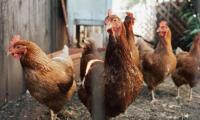HYDERABAD: Wajid Ali, a livestock farmer in a small village of Matriari district, did not understand the odour in grass fodder he collected daily from different cotton fields for his cattle.
He observed that his animals were either reluctant to eat the weeds and grass, or just pecked at it very lazily, despite the fondness they had for the greens, which were nutrient-rich and easily digestible.
Traditionally, poor livestock farmers collect weeds from different cotton farms to feed their animals. It helps them avoid the unbearable cost of fodders like wheat straw, maize, and sorghum, all of which are available at high rates in the local markets.
It is a daily routine of a large number of livestock farmers from the village to leave their abodes early in the morning for collecting a variety of wild weeds from nearby crops. But now the herders have been experiencing this disturbing phenomenon, where animals do not eat the weeds due to the bad odour emanating probably because of the pesticides that cotton farmers use to get rid of unwanted plants.
Wajid Ali said the issue was not just that the cattle were not eating weeds. “The issue is that the animals are losing fertility and productivity due to increasing nutritional deficiencies,” he added.
Weeds were the main source for herders to nourish their animals and maintain their fertility. It was a cheap and easily assessable fodder for them. But now the nutrient-rich fodder has become useless due to obvious reasons.
Information gathered from herders in different areas shows that normally healthy animals take a period of 18 months to two years for breeding. But now small-scale farmers have observed that increasing nutritional deficiencies were delaying reproductive maturity till three to four years, and sometimes five to six years in some animals, leaving farmers in helpless situation.
Under a traditional crop management pact, growers allow herders to clean weeds from their crops. It is a give and take arrangement. Farmers get rid of weeds this way, and herders get cheap fodder for their animals.
Enayat Unar, a farmer in Matiari district, said it was an understanding among farmers that weeds constantly invade crops and they preferred to control it naturally. They used to clean grasses for animals to manage crop plants to grow.
Earlier, farmers used pesticides to get rid of insects, but now they were also using pesticides to kill weeds. This had not only created problems for herders, but also for rural families, who collect wild vegetables from fields for domestic consumption.
Unar said many farmers unknowingly use more pesticides on all crops, thus contaminating grass fodder, water sources, and the overall environment. “That is why many traditional livestock farmers in rural areas keep their animals at makeshift farms,” he added.
Dr Pershotham Khatri, chairman, Department of Animal Reproduction at Sindh Agriculture University Tandojam, said in the past, animals grazed openly, which also allowed them freedom to mate and breed. “But now the situation has changed and mostly animals are fed at cattle pens instead of being allowed to graze in open pastures,” he added.
This lack of freedom coupled with the failure of poor and small herders to arrange for sufficient nutrients for their animals were the main reasons behind the emerging infertility, he added.
“Animals wandering in open grazing fields prefer to eat a variety of plants, reducing the risks and chances of poisoning from any single plant species,” Dr Khatri said. In this natural environment, animals rarely died from over ingestion of toxic plants, provided they have a variety of forages to eat. Also, grazing fields were not contaminated by pesticides.
John Ashley, nutrition-sensitive specialist and coordinator European Union (EU)-funded Programme for improved nutrition in Sindh (PINS-1) said that much of the locally-grown foods in Sindh were unsafe, and contaminated by synthetic pesticides, despite the fact that the provincial government has rules and regulations on governing pesticide practices.
Ashley was quoted in a recent workshop on integrated pest management (IPM) in Hyderabad, where he said the current situation was very nasty, poisonous and synthetic pesticides were being used to kill insects to save fruits and cash crops. That was fine but it was also killing people, as synthetic pesticides were toxic for both insects and people, he said.
“Food safety is a component of food and nutrition security that needs urgent attention. It is a silent crisis, less visible than crises caused by drought, flood or earthquake, though impacting many more people. Pesticides have indirect negative consequences on our health. These include poisoning of air we breathe, there is a surge in visit to rural clinics during cotton spraying times,” he shared observations.
In fact there were a variety of weeds in fields and grazing pastures. Some weeds were toxic or poisonous to livestock, while certain weeds were indigestible, causing a reduction in total intake. Similarly, some weed species have thorns or spines that could injure the grazing animal’s mouth and irritate its eyes. Other weeds could cause the milk and meat of livestock to have a negative taste or odour.
But herders claim to recognise these nutrient-rich weeds, which were beneficial for the growth of animals. Thus they preferred to collect these grasses from crops. The earlier trend of open grazing has already been vanished due to increased crop cultivation, leaving no space for animal rearing.
Livestock is the second largest sector after agriculture, which provides livelihood and food sources to the major portion of population. Since 2006, there has been no livestock census to determine accurate-on-field data in different areas.
In recent debates by experts, livestock department officials, researchers and academia in the province have realised the impacts of nutrition deficiency in livestock, which causes infertility and unproductively in animals.
They suggested growers to adapt alternatives pesticides, which could be made of plants like neem and others to kill insects only, instead of using synthetic pesticides that kill nutrient-rich weeds.
In this picture, the PCJCCI logo can be seen on September 1, 2022. — Facebook/Pakistan China Joint Chamber of...
A representational image of a US flag pictured alongside a street sign reading "Wall Street" in the New York city. —...
A security guard sits in front of a wall with signs and slogans at the operation building at the Pakistan Steel Mills ...
A worker cleans the entrance to the headquarters of Bank Indonesia, the nation's central bank, in Jakarta, Indonesia....
The MCB's logo is seen on a wall outside the bank's head office. — MCB websiteKARACHI: MCB Bank Limited on...
A foreign currency dealer counts US dollars at a shop in Karachi. — AFP/FileKARACHI: The rupee lost ground against...







